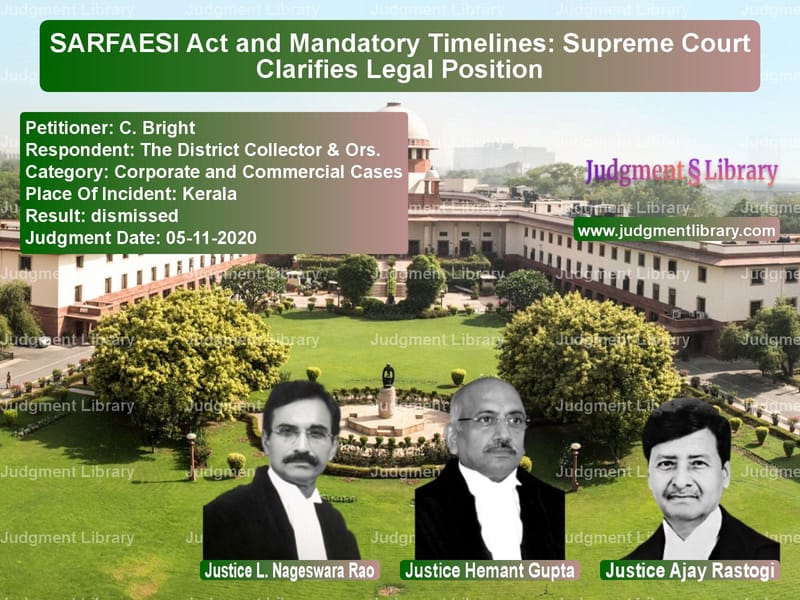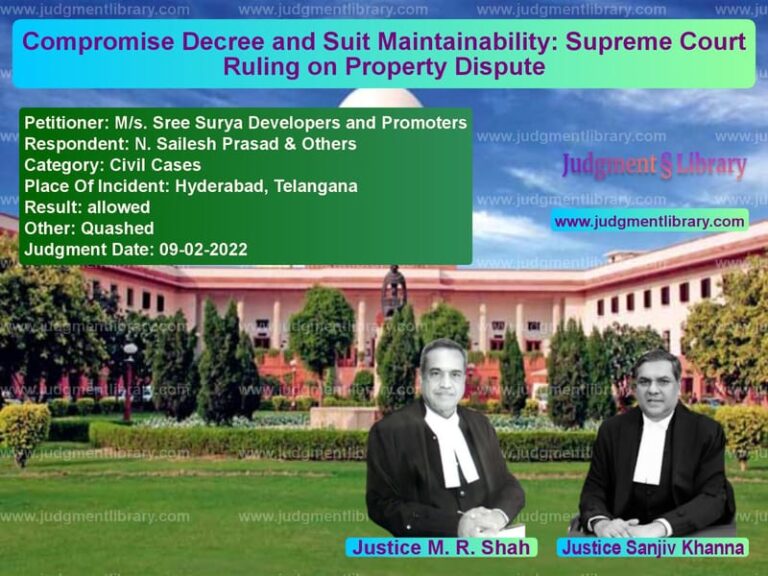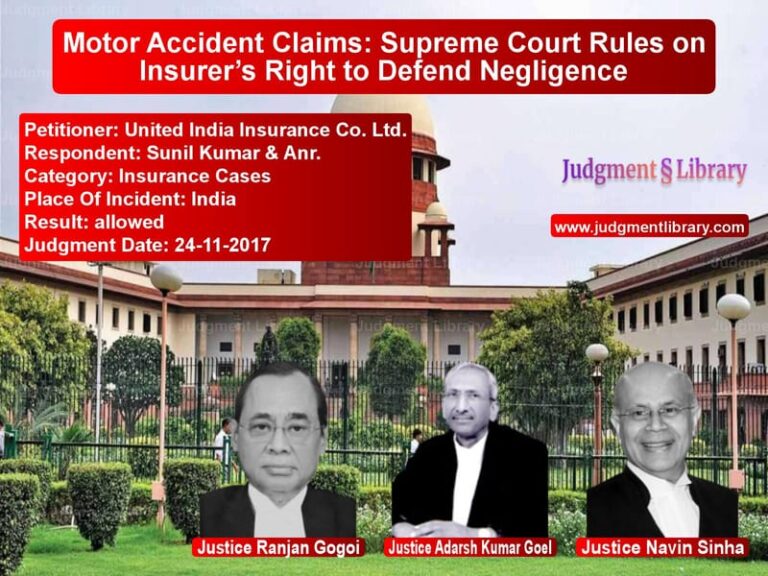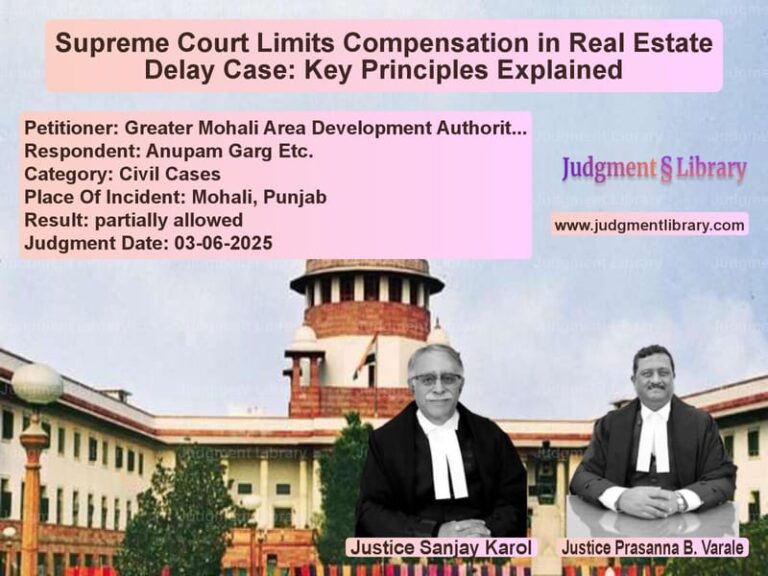SARFAESI Act and Mandatory Timelines: Supreme Court Clarifies Legal Position
The Supreme Court of India, in its judgment in C. Bright v. The District Collector & Ors., has provided clarity on the nature of mandatory timelines prescribed under Section 14 of the Securitisation and Reconstruction of Financial Assets and Enforcement of Security Interest Act, 2002 (SARFAESI Act). The judgment is critical in understanding the obligations of District Magistrates in handling applications by secured creditors for possession of assets. The Court examined whether the timeline of 30 to 60 days for the Magistrate to pass an order is mandatory or directory.
The case arose from a dispute regarding the delayed implementation of Section 14 of the SARFAESI Act, which directs the District Magistrate to deliver possession of a secured asset within 30 days, extendable to an aggregate of 60 days upon recording reasons in writing. The Kerala High Court had ruled that this provision is directory and not mandatory, leading to an appeal before the Supreme Court.
Background of the Case
The SARFAESI Act was enacted to empower banks and financial institutions with mechanisms to recover defaulted loans and reduce non-performing assets. Before its enactment, banks in India lacked sufficient powers to take possession of secured assets without prolonged litigation. To expedite the recovery process, Section 14 mandates that the Chief Metropolitan Magistrate or District Magistrate assist secured creditors in taking possession of secured assets.
The appellant, C. Bright, contested the Kerala High Court’s ruling that the time limit in Section 14 was merely directory and argued that failure to meet the statutory timeline should render the proceedings void.
Petitioner’s (C. Bright) Arguments
The appellant, represented by Mr. Khan, raised the following key arguments:
- The 30-day timeline in Section 14 of the SARFAESI Act should be considered mandatory, as it contains the word “shall.”
- If an order is not passed within 60 days, the secured creditor should be forced to seek alternative remedies.
- The provision must be interpreted strictly to prevent indefinite delays in possession proceedings.
- Failure to comply with the time limit should result in the proceedings abating.
- Precedents such as Union of India v. A.K. Pandey and Dipak Babaria v. State of Gujarat were cited to support the argument that the word “shall” implies a mandatory obligation.
Respondent’s (District Collector & Ors.) Arguments
The respondents contended that:
- The 30-day period was introduced to ensure prompt action but was not intended to strip the Magistrate of jurisdiction if exceeded.
- Interpreting the provision as mandatory would harm secured creditors by forcing them to restart the process in case of minor delays.
- The timeline was meant to impose discipline on authorities but should not be used to nullify the proceedings.
- The purpose of the SARFAESI Act is to enable faster recovery, not to burden creditors with procedural constraints.
- Delays by public authorities should not lead to adverse consequences for financial institutions.
Key Observations by the Supreme Court
1. Literal vs. Purposive Interpretation
The Supreme Court clarified that statutes should be interpreted in a manner that advances their purpose. The Court stated:
“A well-settled rule of interpretation is that the word ‘shall’ does not always mean mandatory and must be examined in the context of the entire statute.”
The Court rejected a purely literal interpretation, emphasizing that the SARFAESI Act was designed to strengthen financial institutions.
2. Public Duty and Directory Nature
The Court noted that when a law imposes a duty on a public functionary, it is generally considered directory unless specific consequences of non-compliance are provided. It stated:
“When the provisions of a statute relate to the performance of a public duty, and holding them mandatory would cause serious public inconvenience, they should be construed as directory.”
The Court highlighted that secured creditors had no control over the actions of the District Magistrate, making a mandatory interpretation impractical.
3. Avoiding Procedural Roadblocks
The Court reasoned that interpreting the timeline as mandatory would create unnecessary hurdles for banks and financial institutions. If the Magistrate failed to act within 60 days, secured creditors would be forced to restart the process, leading to further delays.
4. Comparison with Other Legal Provisions
The Court referred to precedents such as United Bank of India v. Satyawati Tondon, which emphasized minimizing judicial interference in financial recovery processes.
5. Ensuring Effective Implementation
The Court stressed that the Magistrate remains duty-bound to act within the prescribed period. However, delays beyond the stipulated timeline do not invalidate the proceedings.
Final Judgment
The Supreme Court upheld the Kerala High Court’s decision and ruled that:
- The timeline in Section 14 of the SARFAESI Act is directory and not mandatory.
- Failure to meet the 30-60 day deadline does not nullify proceedings.
- The District Magistrate must make an earnest effort to comply with the statutory mandate.
- Secured creditors should not be penalized for delays beyond their control.
Impact of the Judgment
1. Clarity for Financial Institutions
The judgment provides certainty to banks and financial institutions, ensuring that minor delays in judicial proceedings will not disrupt recovery efforts.
2. Strengthening SARFAESI Act Implementation
By ruling that Section 14 is directory, the Court has reinforced the Act’s objective of expediting the recovery of secured assets.
3. Balanced Approach to Legal Interpretation
The decision strikes a balance between enforcing statutory timelines and ensuring practical enforcement of financial regulations.
Conclusion
The Supreme Court’s ruling in C. Bright v. The District Collector & Ors. is a landmark decision that ensures smooth implementation of the SARFAESI Act. While the Court affirmed that authorities must make efforts to act within the prescribed timeline, it clarified that failure to do so does not automatically invalidate the proceedings. This interpretation aligns with the broader goal of enabling financial institutions to recover debts efficiently while maintaining procedural fairness.
The judgment will serve as a guiding precedent for future cases involving statutory timelines in financial regulations and public administrative functions.
Petitioner Name: C. Bright.Respondent Name: The District Collector & Ors..Judgment By: Justice L. Nageswara Rao, Justice Hemant Gupta, Justice Ajay Rastogi.Place Of Incident: Kerala.Judgment Date: 05-11-2020.
Don’t miss out on the full details! Download the complete judgment in PDF format below and gain valuable insights instantly!
Download Judgment: C. Bright vs The District Collect Supreme Court of India Judgment Dated 05-11-2020.pdf
Direct Downlaod Judgment: Direct downlaod this Judgment
See all petitions in Bankruptcy and Insolvency
See all petitions in Corporate Governance
See all petitions in unfair trade practices
See all petitions in Judgment by L. Nageswara Rao
See all petitions in Judgment by Hemant Gupta
See all petitions in Judgment by Ajay Rastogi
See all petitions in dismissed
See all petitions in supreme court of India judgments November 2020
See all petitions in 2020 judgments
See all posts in Corporate and Commercial Cases Category
See all allowed petitions in Corporate and Commercial Cases Category
See all Dismissed petitions in Corporate and Commercial Cases Category
See all partially allowed petitions in Corporate and Commercial Cases Category







